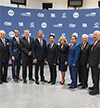Forward-thinking companies are doing just that. For example, global heavy equipment manufacturer Caterpillar, recognizing the disruptive potential of 3D printing and additive manufacturing (AM), has created its “AM Factory” (AMF) — a unique research facility full of the latest AM technologies. Here engineering teams can discover innovative new ways to apply 3D printing to new products, the supply chain, and operations. It allows them to expand how they think about design — even inventing and manufacturing products that can only be made using AM. “To be a leader in the industrial use of additive manufacturing, we knew it was important to increase our efforts in the development of technology,” says Stacey DelVecchio, AM product manager for Caterpillar. “We have 10,000 design engineers at Caterpillar, so getting the tools in place for our engineers to easily access and understand how to use additive in the design process is no small task, but we’re making good progress.”

Another Example
Lowe’s, the home improvement company, established its Innovation Labs several years ago to explore how different disruptive technologies may impact the future of retail. For example, Lowe’s is developing visualization capabilities using virtual reality tools for interacting with their customers. Tango, a new imaging technology developed by Google, combines area learning, depth sensing, and motion tracking to give devices the ability to see their environment in 3D. Lowe’s has partnered with Google and Lenovo to provide a new app that will help its customers virtually measure and style their space.
To be a leader in the industrial use of additive manufacturing, we knew it was important to increase our efforts in the development of technology Stacey DelVecchio, AM product manager for Caterpillar Another virtual reality home improvement design and visualization tool is the “Holoroom,” which creates a more immersive visualization of a home improvement project. Lowe’s is also introducing a 3D printing and scanning service to provide homeowners a simple way to design and produce hard-to-find replacement parts and unique décor items.
“The home is a very personal space and 3D printing gives homeowners unprecedented access to build items that reflect their individuality,” indicates Kyle Nel, executive director of Lowe’s Innovation Labs. “Until now, it’s been hard for the average consumer to benefit from this technology because of the cost and complexity, so we are providing a more approachable and affordable customization experience.”
For any emerging technology, it can be difficult to put together a business case because there is little historical data to help with decision-making. This is when visionary leaders are needed who understand the importance of investing in these technologies and can see the future payoffs. “While this may sound simple, it can be incredibly difficult to do,” says DelVecchio. “The key is investing in these technologies at the appropriate level for your company and finding a leader who will champion the work.”



